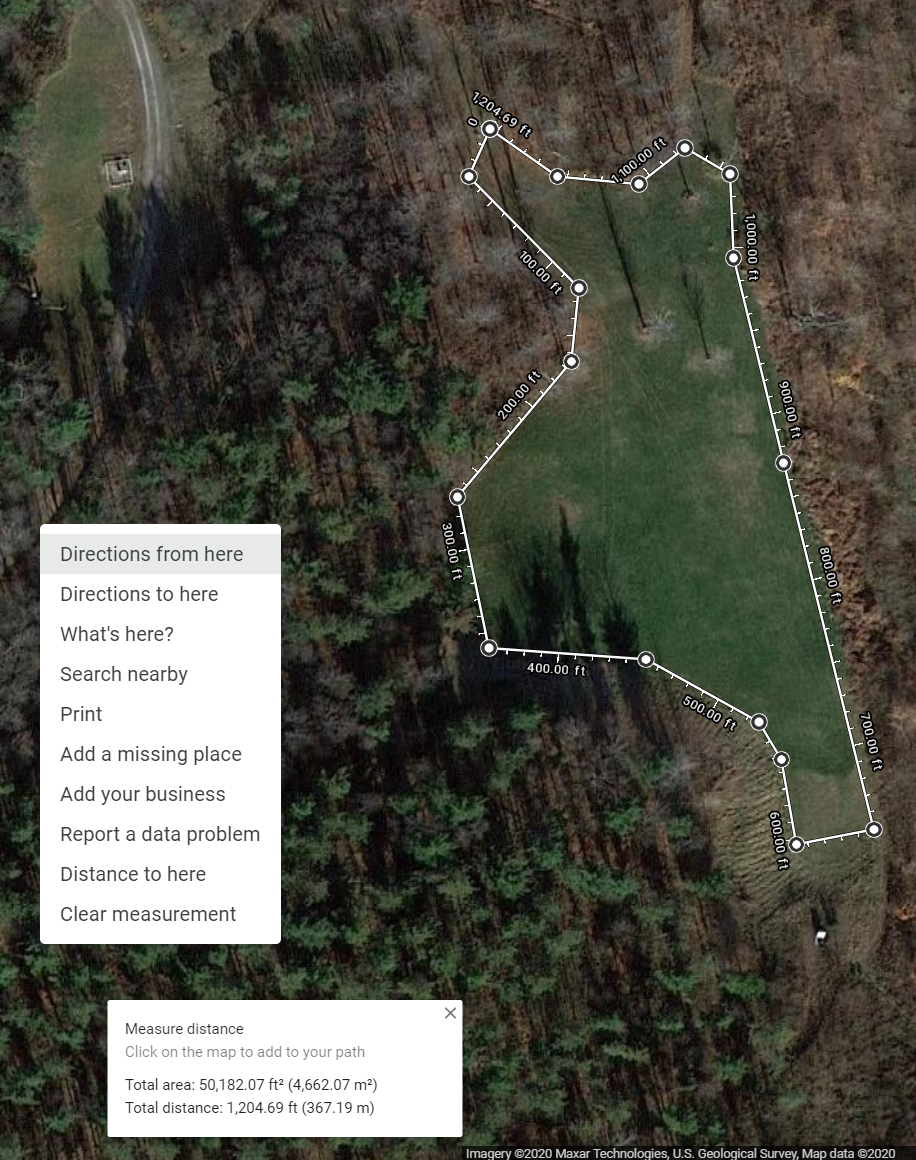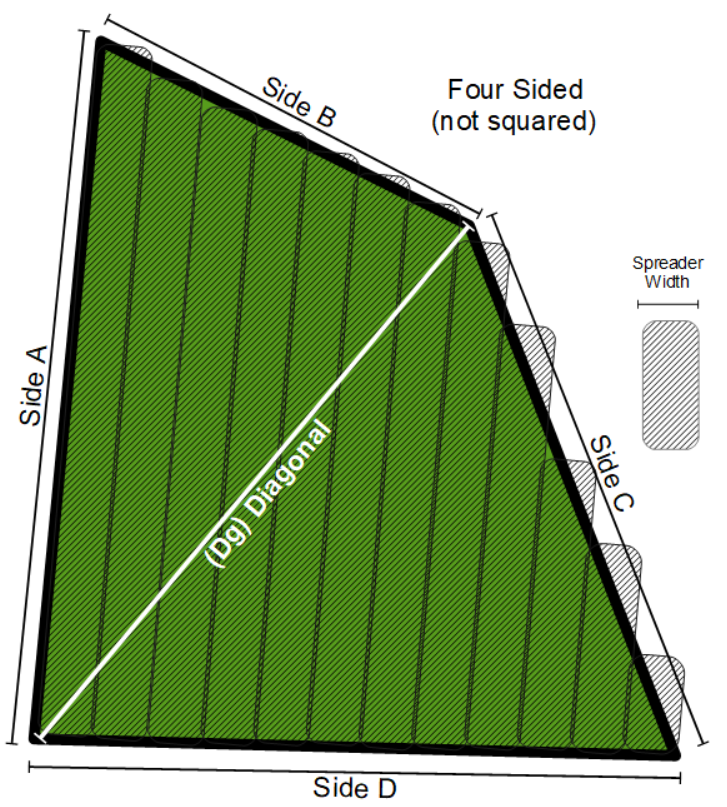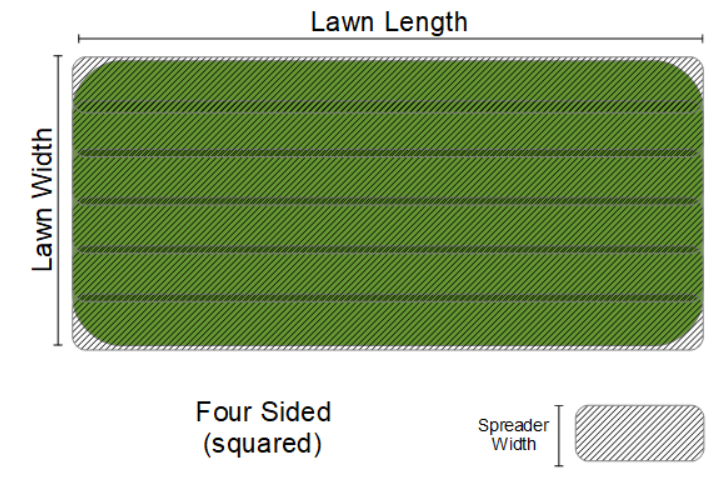The Bales of Straw Needed to Cover Area calculators computes the number of regular square-bales of straw needed to cover an area such as a field or garden. The common bales are 2 string square bales of 14"x18"x"36" inches weighing between 40lbs and 60 lbs.
INSTRUCTIONS: Choose units and enter the following:
- (A) Area Covered
- (PPB) Price per Bale (2 string small bale)
Bales of Straw (BN) : The calculator computes the number of bales of straw needed to cover the area for seed growth, and the approximate cost based on the most recent pricing survey for straw (see below). Pasture covered in oat straw for new grass.
The End Result
How to measure the acres of an field:
- Find the field on Google maps.

- Switch to Satellite View
- Right click to "Measure Distance"
- Left click out the perimeter of the field.
- Toggle the input field for Area (A) in this calculator to square meters
- Calculate the bale of straw for the area
Cost of Straw
vCalc does a regular survey on commodity prices including agriculture products. Here is the most recent market price for straw:
- Date: 9/12/25
- State: USA
- Region: Nation Wide
- Cost of 2 string (40lb to 60lb) bale of Straw: $2 USD
For a video on how to use this calculator, CLICK HERE.
Considerations
When planting grass, it is often recommended to cover the seed with straw to protect the seed and encourage the growth of the grass and retention of moisture. This answers the question, "How much straw do I need to cover grass seed?"
- This formula uses 300 ft2 as the average area covered by one bale of straw or hay. The number of square feet covered was computed in a larger application of 20 bales and averaged out.
- This formula mentions hay. However, straw is better than hay for ground coverage that is trying to encourage undergrowth in applications such as new grass seed. Straw is often a little cheaper than hay. For those who don't know the difference, straw is the remains (stalks) after the grain has been harvested (e.g. wheat and oat straw). Hay is grass that is allowed to grow high and cut before it goes to seed. Hay has significant forage value (nutritional value) for animals like cows and horses where straw typically does not.
- Coverage for planted grass seed is different than coverage as mulch for weed suppression. If you are using straw as mulch (e.g. in a vegetable garden) you will need to make it deeper than covering grass seed. This should make sense. We want the grass to come up and grow in this application, but we want to stifle weeds when mulching. To compute how much straw is needed for mulching, CLICK HERE.
- Square bales are actually rectangular, roughly in the shape of a right parallelepiped (box). This formula returns the number of square bales of straw needed. Straw is typically not processed into the large round bales. That treatment is typically reserved for hay.
Lawn Care Calculators
Mowing Calculator: Estimates the distance walked, area covered, calories burned mowing and time required to mow an area of grass based on mower cutting deck width, speed and whether its a push mower or riding mower.
- Mowing Triangle: Mowing a triangle shaped area.
- Mowing Rectangle: Mowing a rectangle shaped area.
- Mowing 4 Sided non-Squared: Mowing a four sided area that does not have square corners.
- Mowing 5 Sided: Mowing a five sided area.
- Calories Burned Mowing Grass: Estimates the calories burned mowing (push or riding) based on person's weight and time spent mowing grass.
- Lawn Spreader Calculator: Functions to estimate the number of bags of lawn product (grass seed, weed killer, lawn fertilizer, lime) are need to for different shaped lawns (below).
- Lawn Spreader on an Area: Computes the number of bags of lawn treatment (grass seed, weed killer, lawn fertilizer) are needed for a lawn based on the manufacturer recommended area of coverage per bag and the area of the lawn.
- Lawn Spreader Triangle: Computes the number of bags of lawn treatment needed for a triangular lawn based on the manufacturer recommended area of coverage per bag and the length of the three sides of the lawn.
- Lawn Spreader Rectangle: Computes the number of bags of lawn treatment needed for a rectangular lawn based on the manufacturer recommended area of coverage per bag and the length and width of the lawn.
- Lawn Spreader 4 Sided (non-Square): Computes the number of bags of lawn treatment (grass seed, weed killer, lawn fertilizer) needed for a four sided lawn based on the manufacturer recommended area of coverage per bag and the length of the four sides and diagonal of the lawn.
- Lawn Spreader 5 Sided:: Computes the number of bags of lawn treatment (grass seed, weed killer, lawn fertilizer) needed for a five sided lawn based on the manufacturer recommended area of coverage per bag and the length of the five sides and two diagonals of the lawn.
- Grass Seed Calculations use SPREADER calculators above with the grass seed specifications from the manufactures.
- New Sod Calculator: Computes the number of sod pieces needed for an area based on the size of the pieces of sod.
 New Sod Triangle: Computes the number of pieces of sod needed to cover a triangular shaped area such as a yard or field.
New Sod Triangle: Computes the number of pieces of sod needed to cover a triangular shaped area such as a yard or field.- New Sod Rectangle: Computes the number of pieces of sod needed to cover a rectangular shaped area such as a yard or field.
- New Sod 4 Sided: Computes the number of pieces of sod needed to cover a four sided (not squared) shaped area such as a yard or field.
- New Sod 5 Sided: Computes the number of pieces of sod needed to cover a five sided shaped lawn area such as a yard or field.
- New Sod Circle: Computes the number of sod pieces required to cover the given diameter of a circle.
- New Sod Oval: Computes the number of sod pieces required to cover an oval. It also provides the oval area and perimeter.
- Straw Cover Area Calculator: Computes the number of regular square-bales of straw needed to cover an area such as a field or garden for new grass seed. The common bales are 2 string square bales of 14"x18"x"36" inches weighing between 40lbs and 60 lbs.
- Bales of Straw over Rectangle: compute the number of regular square-bales of straw needed to cover new seed on a rectangle area (length by width). .
- Market Price for Bales of Straw: Returns recent market survey on the price of straw bales.

